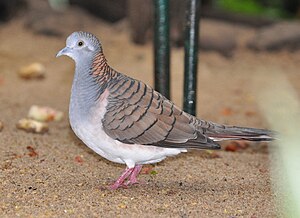Copper-necked pigeon
| Copper-necked pigeon | ||||||||||
|---|---|---|---|---|---|---|---|---|---|---|

Copper-necked pigeon ( Geopelia humeralis ) |
||||||||||
| Systematics | ||||||||||
|
||||||||||
| Scientific name | ||||||||||
| Geopelia humeralis | ||||||||||
| ( Temminck , 1821) |
The copper-necked pigeon ( Geopelia humeralis ), also known as the copper-necked pigeon , is a species of pigeon bird that belongs to the Indo-Australian small pigeons . It is a species of the Australasian avifauna.
Appearance
The copper-necked pigeon reaches a body length of 28 to 31 centimeters. It is thus slightly smaller than a laughing dove and compared to this it has shorter wings and a longer tail. There is no gender dimorphism .
The head, neck, and chest of the copper-necked pigeon are blue-gray. The forehead is a little lighter. The back neck and the upper coat have shimmering copper-red areas, which have led to the name copper-necked pigeon. The rest of the body plumage is light brownish gray. All feathers are narrowly lined with dark, so that the pigeon's plumage looks scaled. The beak is light blue, the iris is greenish yellow. The featherless eye ring is blue-gray.
Possible confusion
There are several ways the copper-necked pigeon can be confused with. The peace dove, which, like the copper-necked dove, is one of the Indo-Australian small pigeons, occurs in Australia. However, this species is significantly smaller than the copper-necked pigeon. The reddish copper areas on the back of the neck and on the upper coat are missing.
The pearl-necked pigeon, which is also found on mainland Australia, is slightly larger than the copper-necked pigeon. It is not cross-banded on the upper side of the body, but spotted.
Distribution area and habitat
The distribution area of the copper-necked pigeon is the northwest, the north and the east of Australia and the south of New Guinea. It occurs in two disjoint areas in New Guinea : the region around Port Moresby and an area along the Fly River . Some islands of the Torres Strait are also settled by it.
The copper-necked pigeon only inhabits habitats near water. These include gallery forests along rivers, forests near water bodies, dense mangrove forests, but also bush areas in semi-deserts, provided that there are enough open water points.
behavior
The copper-necked pigeon looks for food mainly on the ground. It feeds mainly on seeds. The nest is built in a tree or shrub at a low level above the ground. The clutch consists of two eggs. The incubation period is 14 to 16 days. The nestlings fledge after 21 days.
Keeping in human care
The dainty copper-necked pigeons play a role in the keeping of ornamental birds. They were bred for the first time in London Zoo in 1868 and were relatively common caged birds in the second half of the 19th century. Today they are kept as aviary birds.
literature
- Bruce M. Beehler , Thane K. Pratt: Birds of New Guinea; Distribution, Taxonomy, and Systematics. Princeton University Press, Princeton 2016, ISBN 978-0-691-16424-3 .
- David Gibbs, Eustace Barnes and John Cox: Pigeons and Doves - A Guide to the Pigeons and Doves of the World. Pica Press, Sussex 2001, ISBN 90-74345-26-3 .
- Alois Münst and Josef Wolters: Pigeons - The types of wild pigeons. 2nd expanded and revised edition, Verlag Karin Wolters, Bottrop 1999, ISBN 3-9801504-9-6 .
- Gerhard Rösler: The wild pigeons of the earth - free living, keeping and breeding. M. & H. Schaper Verlag, Alfeld-Hannover 1996, ISBN 3-7944-0184-0 .
Web links
- Geopelia humeralis inthe IUCN 2013 Red List of Threatened Species . Listed by: BirdLife International, 2012. Retrieved October 31, 2013.


